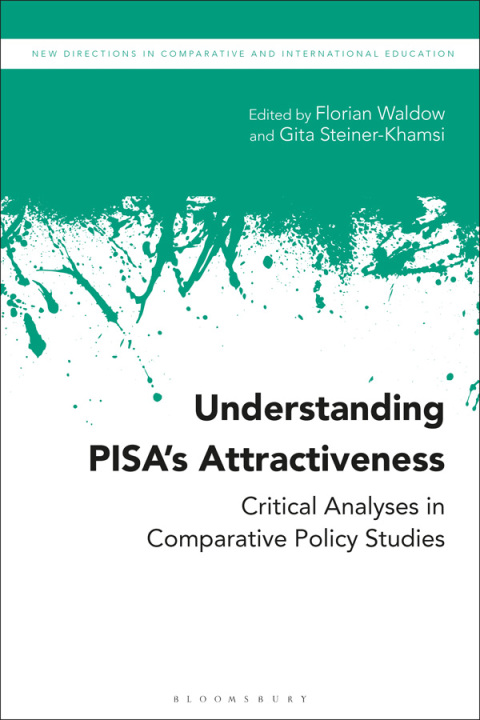Description
Efnisyfirlit
- Cover
- Half Title Page
- Series Page
- Title Page
- Contents
- Notes on Contributors
- Series Editors’ Foreword
- 1 Introduction: Projection in Education Policy-Making
- International large-scale assessments and education policy-making
- Reference Societies, Scandalization, and Glorification
- Projection
- Reference as Projection
- Top Scorers as Projection Screens and Projectors
- Projections as Narratives
- Becoming a Positive or Negative Reference Society: The Role of National Stereotypes
- Externalizing Uneasiness about One’s Own System
- The Chapters
- The Rationale for the Selection of Cases
- Looking from Below: Projections onto PISA Top Scorers
- Coping with Success: Projections by PISA Top Scorers
- Notes
- References
- Part One Looking from Below: Interpreting National Projections into International League Leaders
- 2 PISA Projections in Chile: The Selective Use of League Leaders in the Enactment of Recent Education Reforms
- Introduction
- Context of the Reform: The End of Students’ Selection, Co-payment and Profit in the Chilean Educational System
- The Students’ Movement and the Promotion of Several Educational Reforms
- The Changing Influence of ILSAs in the Chilean Education Policy Arena
- PISA Projections and Reference Societies in Chile
- The Increasing Influence of Finland in Chilean Education Policy-Making
- Projecting Different Slides on the Same Screen: Convergences and Divergences within the Political Spectrum
- Regional Absences and Emerging Projection Screens in the Chilean Education Debate
- Conclusions
- Notes
- References
- 3 Schooling Reform in Australia: Legitimation through “Projections” onto Shanghai and East Asian Schooling Systems
- Introduction
- PISA in Australia
- Shanghai’s Performance on PISA 2009 and 2012
- Australia’s Mediated Response to Shanghai’s PISA Performance
- Theorizing Australian Projections onto East Asian Schooling Systems
- Conclusion
- Notes
- References
- 4 “Pedagogical Paradise” and “Exam Hell”: PISA Top Scorers as Projection Screens in German Print Media
- Introduction: Reference Societies after the German “PISA Shock”
- Data and Methods
- Data
- Frame Analysis
- Reference Societies in Germany after PISA
- Finland and “Asia” in the Media: Timing of the References
- Finland as a Positive Reference Society
- “Asia” as a Negative Reference Society
- Conclusion
- Notes
- References
- 5 Nordic Reference Societies in School Reforms in Norway: An Examination of Finland and the Use of International Large-Scale Assessments
- Introduction
- Policy Borrowing by Governance and Evidence
- Methods and Analytical Approach
- Nordic Participation in ILSAs
- A Comparison across Time and ILSAs
- References to ILSAs and Projections of Finland
- Policy Domains and References to ILSAs
- Conditions for Schooling
- Curriculum Policies
- Quality and Development of Basic Education
- Learning Assessment as a Key Instrument for Improving the Quality of Education
- Professional Development
- Projections of the Finnish Education System
- Discussion
- Reference Systems in Norway
- Participation in ILSAs
- The Projection of Finland
- Notes
- References
- 6 PISA Rhetoric and the “Crisis” of American Education
- Introduction
- Conceptual Framework
- The US Case
- Methods and Data
- Findings
- “China”
- Country References to PISA over Time
- US Response to PISA over Time
- Explanations of Top Scorers’ Success
- Chinese Success
- Finnish Success
- Discussion
- Conclusion
- Notes
- References
- Part Two Coping with Success: International Projections and National Counter Narratives
- 7 The Use of PISA Results in Education Policy-Making in Finland
- Introduction
- Uniform Comprehensive School Model and Segregating Trends
- Research Task, Data, and Methods
- Equality Nobility at Risk and the Need to Stay a “Cutting-Edge Country”
- Building Up Education Export Policies Using the Country’s PISA Brand
- Conclusions and Discussion: What Does PISA Mean to Finnish Education Policy Agenda-Setting?
- Appendix List of Analyzed PISA-Related Ministry of Education and Culture (MoEC) Press Releases and Government Programs in Finland between 1999 and 2016
- Notes
- References
- 8 PISA and Self-Projection in Shanghai
- Introduction
- Self-projection, Introjection, and Projection
- The Study
- Method
- Findings and Discussion
- Self-image Projected by the Chinese Education Officials
- Kleinian Introjection and Projection
- Conclusion
- References
- 9 Curse or Blessing? Chinese Academic Responses to China’s PISA Performance
- Introduction
- China’s Participation in PISA
- Chinese Academic Responses to Shanghai’s PISA Success
- Looking West: Learning from PISA
- Looking East: China as an Educational Role Model
- Students as Testing-Machines, or Individual Welfare?
- Do Assessment Tests Reflect Educational Quality?
- International Student Assessments and Their Discontents: Agendas behind the Debate
- Mixed Blessings: Grounding Educational Reform, or Making China Great Again?
- PISA’s Threefold Curse
- Conclusion
- Notes
- References
- 10 Excellence and Envy: The Management of PISA Success in Singapore
- Most Improved Systems: League Leaders and Icons of Excellence
- PISA Success and Education Reform
- Education Reform: From Efficiency to Excellence
- PISA as an Endorsement of Education Reform
- PISA Envy: Projections of Educational Enjoyment
- Conclusion: “Changing Parents’ Mindset”
- Notes
- References
- 11 Perceptions of the East Asian Model of Education and Modeling Its Future on Finnish Success: South Korean Case
- Introduction
- Perception of the East Asian Model of Education
- Referencing Finnish Education
- Achievement
- Equity
- Teachers
- Quality
- Conclusion
- Note
- References
- 12 Conclusions: What Policy-Makers Do with PISA
- The Power of Soft Power
- The Main Lines of Argumentation
- Reception versus Diffusion
- Externalization as a Critical Event
- Transnational Accreditation of Twenty-First-Century Skills
- The Economization of Education
- The Semantics of PISA
- References
- Index
- Copyright Page







Reviews
There are no reviews yet.